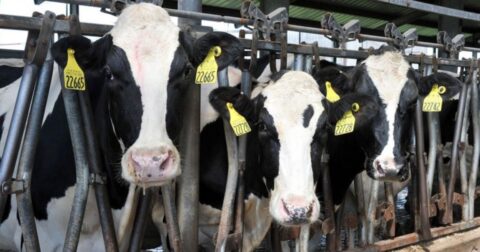Fact Check
There Is Nothing Especially Healthy About Regenerative Meat
Health•4 min read
Reported
Cows in Texas, Kansas and New Mexico have tested positive for bird flu.


Words by Gabriella Sotelo
Since late January, a mystery illness began to appear in older cows in three states — showing up on dairy farms in Texas, Kansas and New Mexico. A troubling pattern began to emerge: a drop in cow milk production, cows not willing to eat and symptoms that last 10 to 14 days. On some farms, dead wild birds were found. By March 25, the ‘mystery’ was confirmed — highly pathogenic avian influenza, commonly known as the bird flu. The virus has now been found in farms on five states in total: Idaho, Kansas, Michigan, New Mexico and Texas.
The bird flu is a virus that naturally and normally spreads among birds, but under the right conditions, it can spread like wildfire. The highly pathogenic avian influenza, in comparison to less virulent versions of the illness, can cause severe disease to appear among birds and also high mortality rates.
In the United States alone it has affected more than 82 million birds since 2022, according to the CDC. But recently the flu has been spreading to both land and sea mammals, creating new worries. Since mammals are biologically closer to humans, the World Health Organization has warned the virus might adapt to infect humans more easily.
Just last year a study was released detailing how avian flu is mutating, and how it has been able to severely affect mammalian brains. The disease has spread to bears, otters and in rare cases, humans, with the first case appearing in 2022 in the United States.
Research suggests that conditions on factory farms, where animals are often kept in crowded, filthy and stressful environments, serve as the ideal setting for disease to spread amongst animals — conditions that make disease outbreaks hard to prevent. The outbreak in Texas and Kansas seems to be the first case of avian flu appearing in cattle. But for now, initial testing done by the National Veterinary Services Laboratory has found that there are no changes to the virus that would make it more transmissible to humans.
Even though the illness is affecting dairy cows — causing them to experience a fever, reduced appetite, pneumonia, clogged milk ducts or producing thicker and yellowish milk — the bird flu outbreak has not impacted the milk supply, officials say. When dairy farms send their milk to processing, they can only send milk from healthy animals, in this case healthy cows. Any milk from cows that were infected would be diverted or destroyed, according to USDA guidelines. Commercial milk, as in the milk that you would get at the grocery store, also has to go through pasteurization, which inactivates any bacteria or viruses, including the flu virus.
Questions remain about exactly how the virus is spreading among dairy cows. Andrew Bowman, a molecular epidemiologist and influenza expert at Ohio State University, told The New York Times that it is unclear right now whether or not the infected cows have gotten the virus directly from birds, or if the virus is also spreading from one cow to another.
Of the impacted herds, on average around 10 percent of cows have become sick, with most cases appearing in older cows. It also has also led to 10 to 20 percent reduction in milk production in the affected cows, though, again, any milk produced by affected cows will not appear on grocery shelves.
The USDA is not requiring farmers to euthanize the affected cows. But farmers with affected herds may be able to receive compensation or “livestock assistance” under one of the USDA’s Disaster Assistance Program, which “provides emergency assistance to eligible producers of livestock, honeybees and farm-raised fish for losses due to disease.” It is unknown whether this will include the bird flu, and whether farmers can account for any related loss when filing in the following year.
The USDA insists the outbreak will not impact the dairy market. “Milk loss resulting from symptomatic cattle to date is too limited to have a major impact on supply and there should be no impact on the price of milk or other dairy products,” the agency said in a statement.
Still, if the outbreak in dairy herds were to keep spreading, the virus could lead to market disruptions — and more farm animals at risk of disease and, ultimately, death.
Update: this piece has been updated to reflect that the outbreak on dairy farms has now been documented in five states.